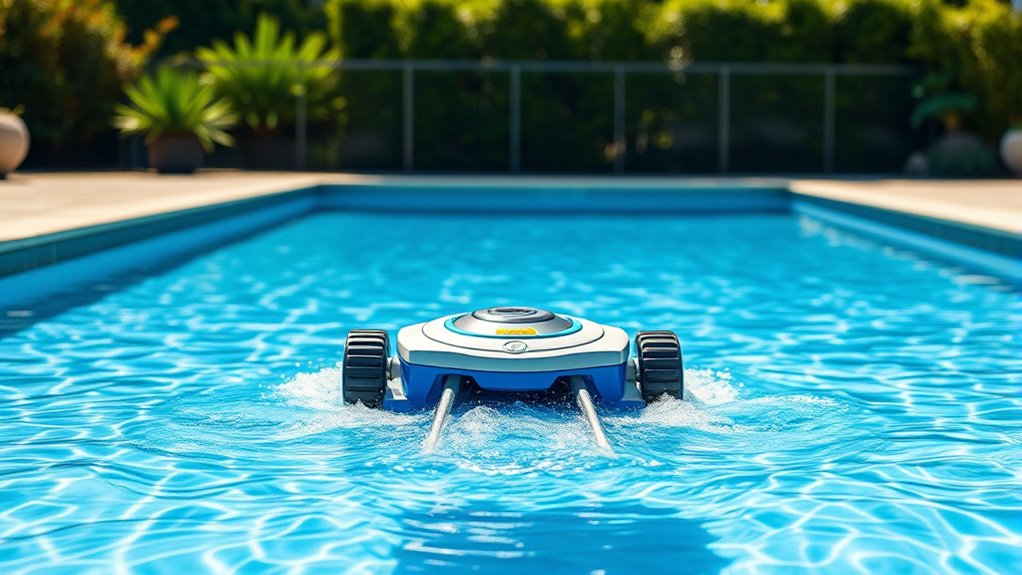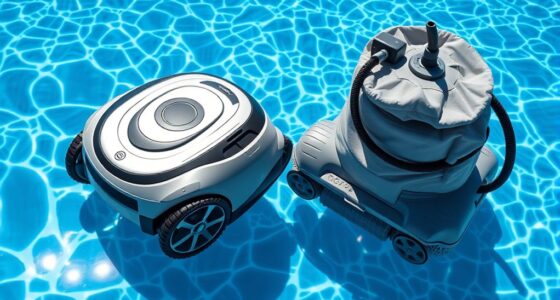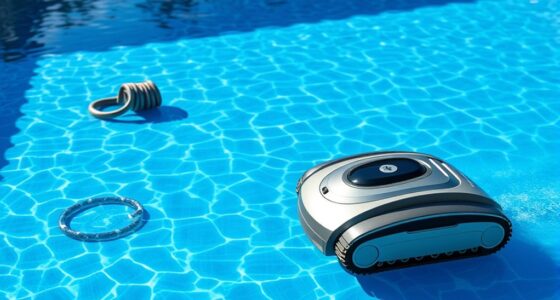You should run your pressure pool cleaner daily for 1-2 hours, especially during warm months or when debris is heavy, to keep your water clear and prevent buildup. In cooler weather or with less debris, you might need less frequent cleaning, like weekly sessions. Keep an eye on water chemistry and debris levels—if you notice more debris or filter strain, it’s time to increase cleaning. For detailed tips, continue exploring key maintenance strategies.
Key Takeaways
- Run the pressure cleaner daily for 1-2 hours during high debris or algae-prone seasons.
- Increase cleaning frequency after storms or heavy foliage to prevent debris buildup.
- Reduce cleaning in cooler months with balanced water and less debris accumulation.
- Adjust cleaning times based on water temperature, chemical balance, and filter condition.
- Regularly inspect and clean filters and hoses to maintain efficiency and prolong equipment lifespan.
Factors Influencing Cleaning Frequency
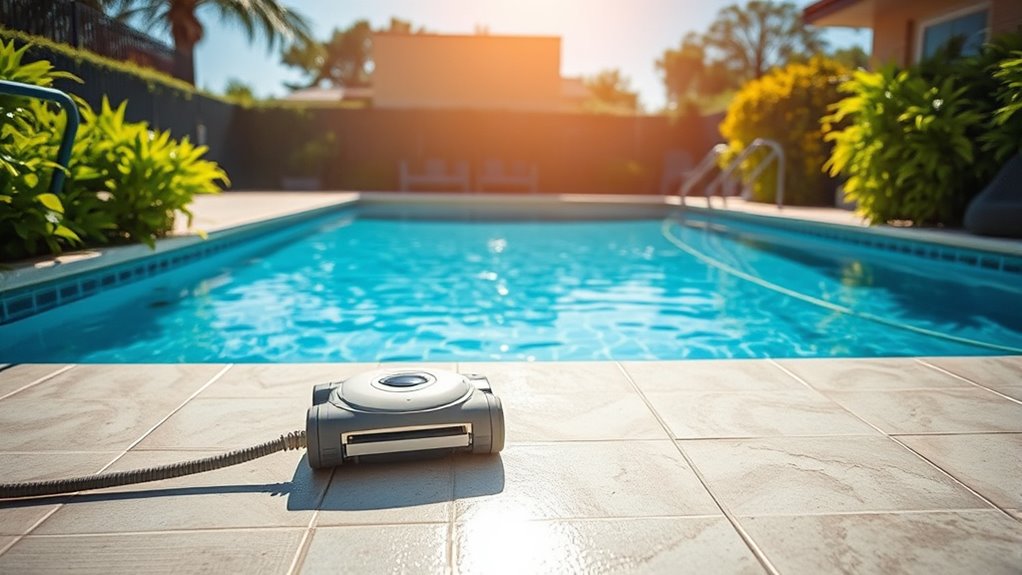
Several factors can influence how often you should run your pressure pool cleaner. One key element is the chemical balance of your pool water; if pH or sanitizer levels are off, debris and algae can accumulate faster, requiring more frequent cleaning. Water temperature also plays a role—warmer water promotes algae growth and increases debris, meaning you might need to run your cleaner more often during hot months. Additionally, if your pool sees heavy use or is located near trees or planting areas, you’ll likely need to clean more frequently. Monitoring these factors helps you determine the most suitable cleaning schedule, ensuring your pool stays clear and balanced without overworking your pressure cleaner. Regularly checking the water chemistry can help you better understand when to run your cleaner more often. Keeping an eye on debris accumulation can also guide your cleaning routine as conditions change, helping you maintain optimal pool clarity and hygiene. Understanding filter maintenance is crucial because a clean filter improves overall circulation and reduces the workload on your pressure cleaner. For optimal performance, consider inspecting your pressure cleaner components regularly to prevent potential issues and ensure efficient operation. Adjust your routine as conditions change to keep your pool in top shape.
Recommended Daily and Weekly Run Times

Knowing how long to run your pressure pool cleaner each day and week helps keep your pool crystal clear without wasting energy. You should consider the most suitable daily duration, your regular maintenance schedule, and other factors that influence usage. To optimize efficiency, it’s essential to understand the recommended run times for your specific equipment and pool size. Proper operation can also prevent potential issues, such as equipment damage or inefficient cleaning performance. Additionally, aligning your pool cleaning schedule with tuning principles can enhance overall efficiency and longevity. Let’s explore how to determine the best run times for your pool. For those with a Mazda Tuning background, understanding optimal operation times can be compared to tuning a vehicle for peak performance without overexertion or inefficiency performance optimization.
Optimal Daily Duration
To keep your pool clean and the pressure cleaner functioning efficiently, it’s important to run the device for the right amount of time each day. Generally, 1 to 2 hours daily is effective, but this depends on factors like pool size, water temperature, and pool chemical balance. When water temperatures are higher, algae growth speeds up, requiring longer cleaning sessions. Maintaining proper pool chemical balance helps prevent debris buildup and keeps the cleaner working smoothly. If the water is cooler and chemicals are balanced, 1 hour may suffice. Conversely, warmer water or increased debris might mean extending cleaning time to ensure ideal results. Consistent daily operation keeps your pool clear, saves energy, and reduces the need for intensive weekly cleaning. Additionally, understanding how biodiversity impacts your local environment highlights the importance of maintaining healthy ecosystems beyond just your pool. Proper filter maintenance can also extend the life of your pressure cleaner and improve its efficiency over time.
Weekly Maintenance Schedule
Establishing a weekly maintenance schedule guarantees your pool stays clean and your pressure cleaner operates at peak efficiency. You should run your cleaner for about 2-3 hours weekly, depending on pool size and debris. During this time, focus on chemical balancing to prevent algae and maintain water clarity. Also, check pool lighting to ensure bulbs are functioning properly, as it helps monitor cleanliness. Regularly inspect and clean the filter to keep debris from clogging your pressure cleaner. Here’s a quick guide:
| Task | Frequency | Duration |
|---|---|---|
| Run Pressure Cleaner | Weekly | 2-3 hours |
| Chemical Balancing | Weekly, after cleaning | N/A |
| Check Pool Lighting | Monthly | 5-10 minutes |
| Filter Cleaning | Weekly | 15-20 minutes |
Routine maintenance also includes monitoring sustainable materials used in pool equipment, which can help reduce environmental impact and improve long-term performance.
Factors Affecting Usage
The frequency at which you run your pressure pool cleaner depends on several key factors, including your pool’s size, usage patterns, and the amount of debris it collects. A well-balanced pool chemical balance prevents algae and helps the cleaner operate efficiently, reducing the need for frequent runs. If your pool sees heavy use or is surrounded by trees, you’ll need to run the cleaner more often. Regular skimmer basket cleaning prevents blockages that can hinder performance. Additionally, larger pools may require longer or more frequent cleaning sessions. Keep an eye on debris levels and water clarity; these are good indicators of when to run your cleaner. Monitoring digital literacy programs can also assist seniors in managing smart pool equipment effectively. Properly understanding your pool’s maintenance needs can help you develop an optimal cleaning schedule. Staying informed about AI-powered monitoring tools can enhance your ability to maintain a healthy swimming environment. Using remote control systems can also help you adjust cleaning routines more precisely. Adjust your schedule accordingly to maintain a clean, safe, and healthy swimming environment, and considering the cost-efficiency of your cleaning routine can help save money over time.
Adjusting for Pool Usage and Size
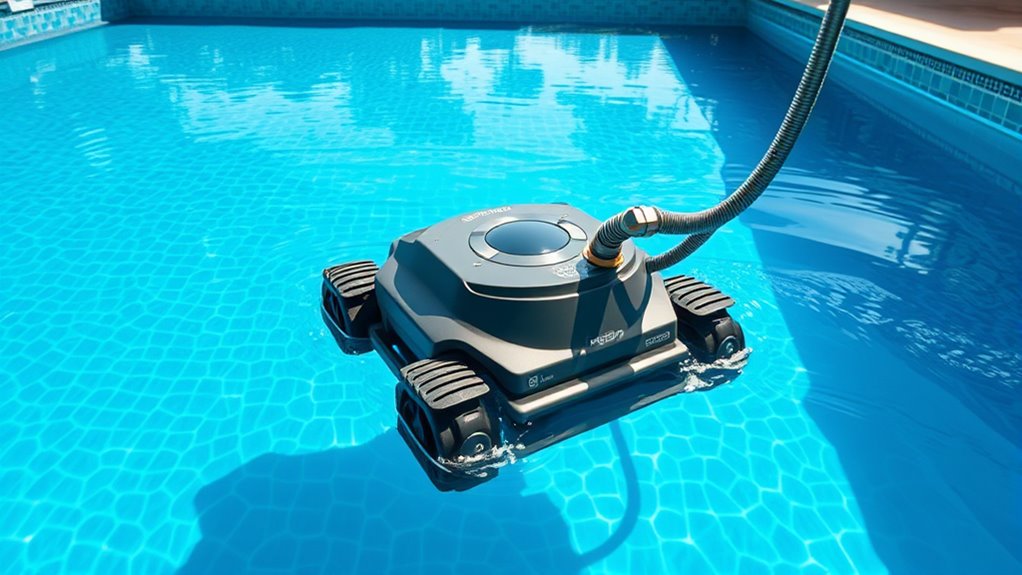
Adjusting your pressure pool cleaner’s schedule based on how often and how heavily you use your pool guarantees it stays clean without unnecessary run time. If you swim daily or host frequent gatherings, you’ll need to run the cleaner more often. Conversely, if usage is light, less frequent runs suffice. Remember, maintaining proper pool chemical balance enhances cleaning efficiency and ensures safety. Regularly check pH levels and sanitizer levels to prevent algae and bacteria buildup. When adjusting your schedule, consider your pool’s size—larger pools require more time and power. Implementing these adjustments helps conserve energy and prolongs equipment life while keeping your pool safe and inviting. Additionally, monitoring your security zone info can provide insights into protecting your pool area from unauthorized access and potential security threats. Proper pool maintenance routines, including timely cleaning and chemical adjustments, are essential for optimal performance. Ensuring your pool equipment is well-maintained also contributes to efficient operation and longevity. Regularly inspecting your pressure pool cleaner for wear and tear can prevent unexpected breakdowns and maintain cleaning efficiency. Always follow pool safety tips to ensure a clean, healthy swimming environment.
Environmental Considerations and Seasonal Changes
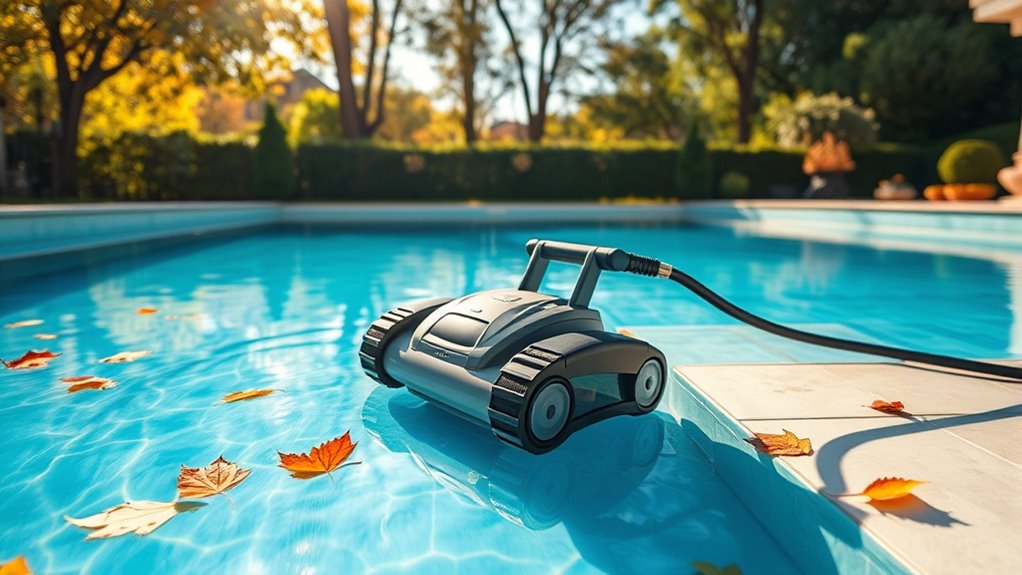
Environmental factors and seasonal changes substantially impact how often you should run your pressure pool cleaner. During windy months, debris like leaves and dirt accumulate faster, requiring more frequent cleaning. In colder seasons, algae growth and chemical imbalances may increase, affecting pool chemical balance. Maintaining your pool cover properly helps reduce debris and keeps your pool cleaner longer. Consider this table:
| Season | Environmental Impact | Recommended Frequency |
|---|---|---|
| Spring | High pollen, debris | Weekly or after storms |
| Summer | Increased algae, sunlight | 2-3 times weekly |
| Fall | Falling leaves, wind | 2 times weekly |
| Winter | Less use, debris accumulation | Monthly or as needed |
| Off-season | Minimal use, cover on | Periodically check |
Adjust your cleaning schedule based on these factors to keep your pool balanced and well-maintained.
Signs That Indicate Your Pool Needs More Frequent Cleaning
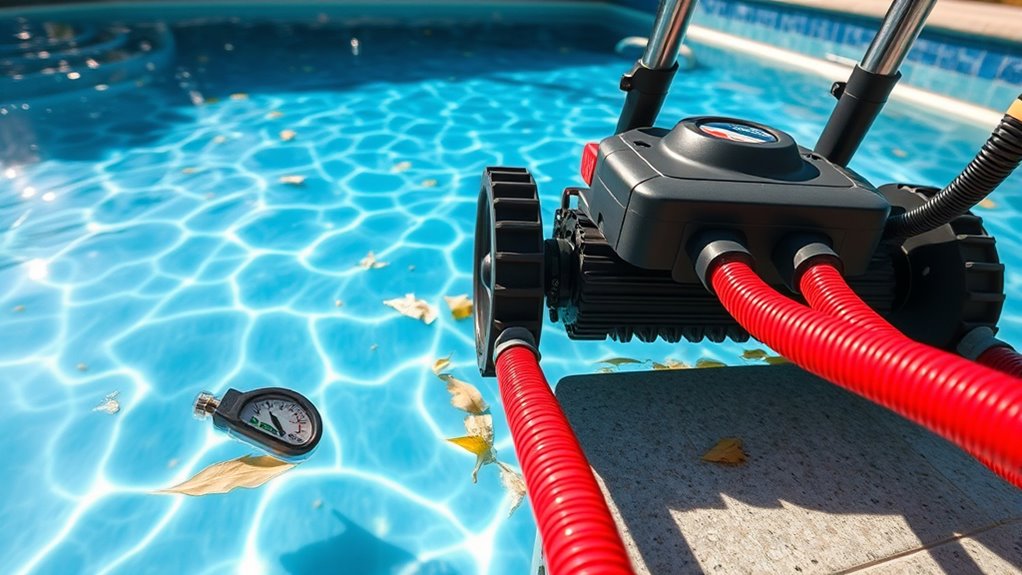
If you notice visible debris floating or settling on the pool floor, it’s a clear sign you need to clean more often. Additionally, when your filter strains more quickly or requires frequent backwashing, it indicates your pool is accumulating more dirt. Keeping an eye on these signs helps guarantee your pool stays clean and the cleaner functions efficiently.
Visible Debris Accumulation
When you notice leaves, dirt, or other debris floating on the surface or settling at the bottom of your pool, it’s a clear sign your cleaner isn’t keeping up. Visible debris indicates you need more frequent cleaning, especially if the water temperature encourages algae growth. Also, check your chemical balance regularly; imbalanced chemicals can cause debris to cling to surfaces.
| Debris Level | Water Temperature | Chemical Balance |
|---|---|---|
| Light | Cooler | Balanced |
| Moderate | Warm | Slightly Imbalanced |
| Heavy | Hot | Imbalanced |
If debris persists despite regular cleaning, consider increasing your pressure pool cleaner’s run times to maintain a clean, inviting pool.
Increased Filter Strain
A noticeable increase in your filter’s workload is a clear sign that your pool needs more frequent cleaning. When your filter has to work harder, it’s often due to debris buildup or unbalanced pool chemical levels that foster dirt accumulation. Additionally, water temperature plays a role; warmer water speeds up algae growth and debris breakdown, causing filters to strain sooner. If you notice your filter clogging faster or needing more frequent backwashing, it’s time to clean your pressure pool cleaner more often. Maintaining proper pool chemical balance helps reduce debris and algae, easing filter stress. Regular cleaning ensures your pool stays clear and your equipment functions efficiently, especially when water temperatures rise. Pay attention to these signs to keep your pool in ideal condition.
Preventative Maintenance for Your Pressure Cleaner
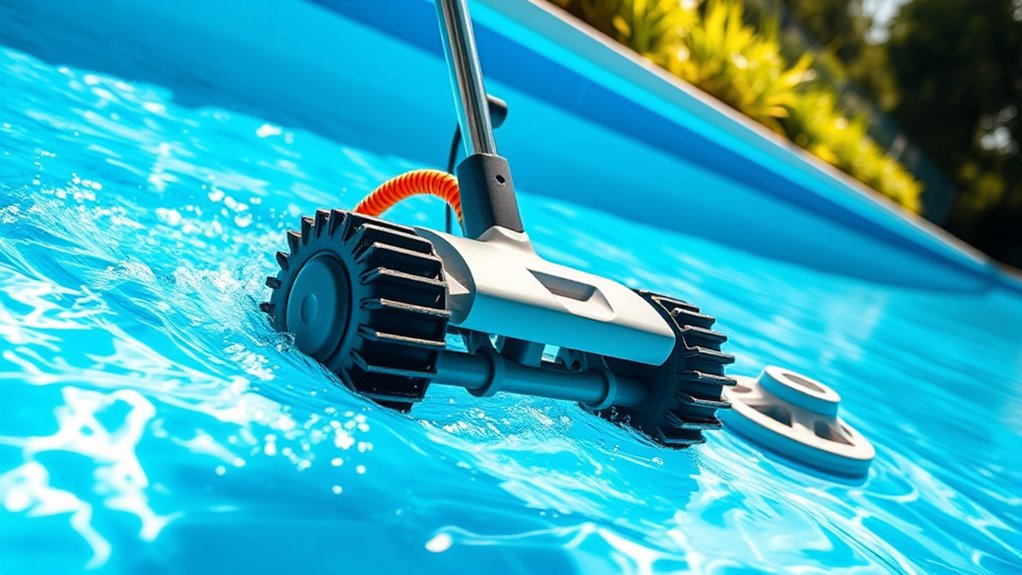
Regular preventative maintenance is essential to keep your pressure pool cleaner running efficiently and extending its lifespan. Start by regularly checking chemical balancing; proper levels prevent corrosion and buildup that can impair the cleaner’s parts. Clean and inspect your pool lighting to ensure it’s not attracting debris or causing uneven cleaning. Keep an eye on hoses and connections, tightening or replacing any worn-out parts. Rinse your pressure cleaner after each use to remove dirt and debris, and store it in a dry, shaded area to prevent damage. Periodically review manufacturer guidelines for specific maintenance tasks. Staying proactive with these steps reduces the risk of breakdowns, improves cleaning performance, and prolongs your pressure cleaner’s life, making your pool maintenance more effective and hassle-free.
Balancing Efficiency and Equipment Longevity
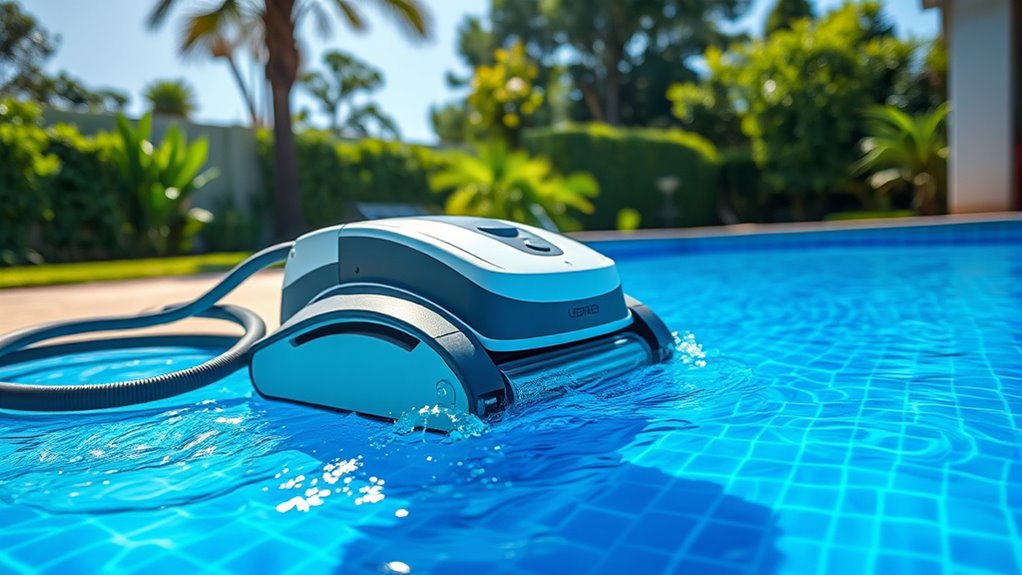
Balancing efficiency and equipment longevity requires careful adjustment of your pressure pool cleaner’s settings and maintenance routine. Maintaining proper chemical balance prevents algae buildup and reduces strain on your cleaner, ensuring it operates smoothly. Regularly check and adjust pH and sanitizer levels to keep the water balanced, minimizing debris that can clog or damage parts. When your pool is covered with a pool cover, debris may accumulate differently, so you might need to run the cleaner more or less often. Avoid overworking your pressure cleaner, as excessive use can lead to wear and tear. Proper maintenance, including cleaning filters and inspecting hoses, combined with attention to chemical balance and pool cover conditions, helps extend your equipment’s lifespan while keeping your pool clean and clear.
Frequently Asked Questions
Can Running the Cleaner Too Often Damage the Pool Equipment?
Running your pressure pool cleaner too often can indeed impact your pool maintenance and harm equipment longevity. Overuse may cause unnecessary wear on the pump and filtration system, leading to potential breakdowns. To keep your pool in top shape, you should run the cleaner as needed—usually a few times a week—while ensuring proper maintenance routines. This approach balances effective cleaning with preserving your equipment’s lifespan.
How Does Water Temperature Affect Cleaning Frequency?
Think of your pool like a garden; warmer water is like summer sun, encouraging faster growth and dirt buildup. When water’s warmer, you should run your pressure pool cleaner more often to maintain proper water circulation and chemical balance. For example, in 80°F water, dirt settles quickly, so frequent cleaning prevents algae. Adjust your cleaning schedule based on temperature to keep your pool sparkling and healthy.
Should I Run the Cleaner During Pool Parties or High Usage Days?
During pool parties or high usage days, you should run your pressure pool cleaner more frequently. Increased activity causes more debris accumulation and can affect pool chemicals’ balance. Running the cleaner helps remove debris and keeps the water clean, reducing strain on your filter and maintaining proper chemical levels. This way, you guarantee a safe, inviting swimming environment, even during busy days.
What Impact Does Nearby Landscaping Have on Cleaning Schedules?
You might think nearby landscaping doesn’t affect your cleaning schedule, but landscape debris and plant overgrowth can quickly clog your pressure pool cleaner. To keep your pool sparkling, you’ll need to run it more frequently when trees shed leaves or plants grow rapidly. Regularly clearing debris from the skimmer and monitoring plant growth helps prevent blockages, ensuring your cleaner works efficiently and your pool stays inviting.
Is It Necessary to Run the Cleaner After Heavy Rain or Storms?
After heavy rain or storms, it’s essential to run your pressure pool cleaner. Rain impact causes debris accumulation in your pool, which can clog filters and reduce water quality. Running the cleaner helps remove leaves, dirt, and other debris quickly, maintaining clear water and protecting your pool’s equipment. Regular cleaning after storms guarantees your pool stays safe, clean, and ready for use.
Conclusion
So, while you might think running your pressure pool cleaner daily keeps your pool perfectly pristine, remember, even the most diligent swimmer needs a break. Overworking your cleaner can turn it into a tired, sputtering mess, leaving your pool dirtier than before. Ironically, the secret to a sparkling pool isn’t endless running but knowing when to give your cleaner a breather. Sometimes, less truly is more—until it’s time for that well-earned spa day.

